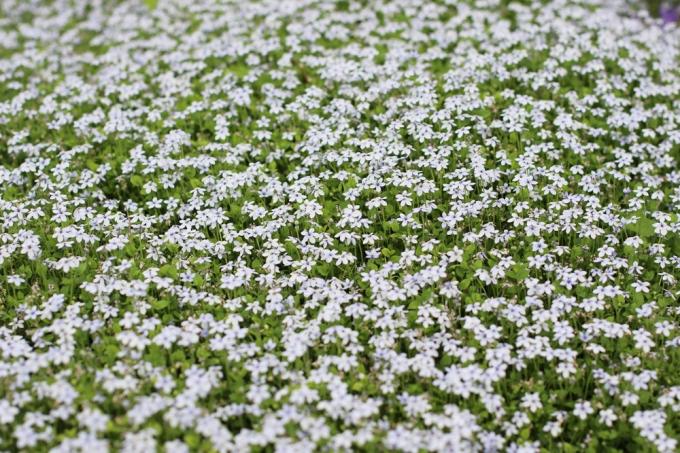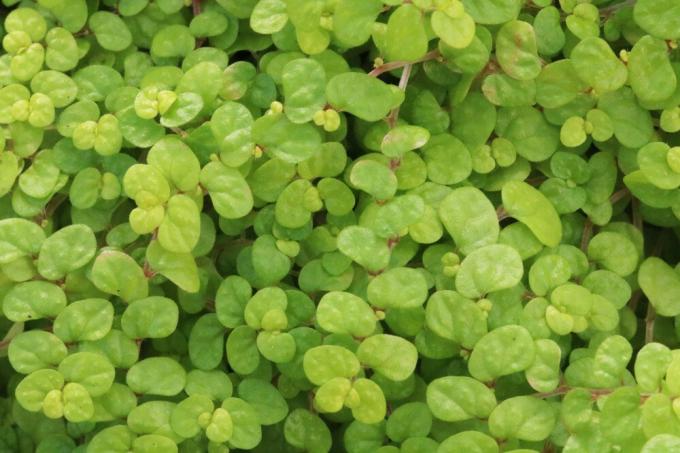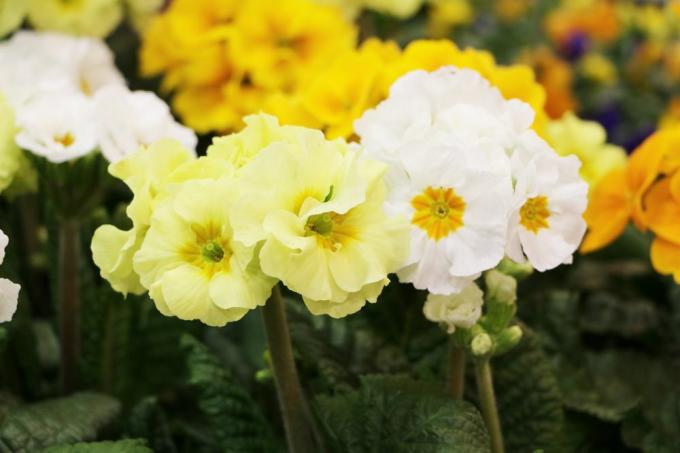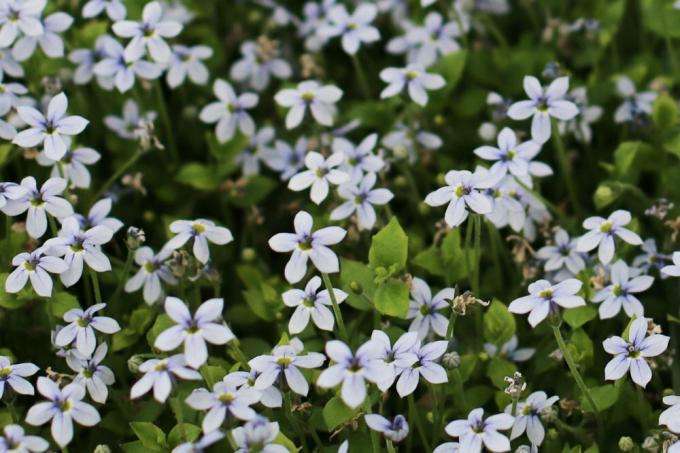
table of contents
- Care instructions
- Heyday
- Soil condition & location
- Fertilize
- to water
- Diseases & pests
- Bucket cultivation
- plants
- Plant neighbors
- Cut
- Overwinter
- Multiply
Profile and care information open +conclude -
- Flower color
- White blue
- Location
- Partial shade, sunny
- Heyday
- May, June, July, August, September, October
- Growth habit
- flat-growing, perennial
- height
- up to 10 centimeters high
- Soil type
- loamy
- Soil moisture
- fresh
- PH value
- neutral, weakly alkaline
- Limescale tolerance
- Calcium intolerant
- humus
- rich in humus
- Poisonous
- no
- Plant families
- Bellflower family, Campanulaceae
- Plant species
- Bedding plants, ground cover, border flowers
- Garden style
- Flower garden, natural garden
Blue bobble head is available in stores under many names. It is also known by many hobby gardeners as isotoma and false or carpet lobes. The blue bobblehead is originally native to Tasmania and the Australian southeast coast and prefers acidic and humid locations here. Due to the similar prevailing conditions in the local latitudes, the plant can also be cultivated in the garden. How the ideal care of the decorative ground cover should look like is explained in the further instructions.
Care instructions

If the decorative ground cover is given the desired location and soil conditions, it is quite easy to cultivate and a valuable eye-catcher in every garden bed for many years. The hardy perennial quickly forms many runners if it feels comfortable in the chosen location and can thus cover an entire bed as a dense carpet for a short period of time. Even if small flowers form, the plants are only about five to ten centimeters high. If the location is too dry, then a lot of watering is required. If a blue bobble head grows too lush, it can be contained by stabbing it. Propagation can take place in the same way. Even mowing does not prevent the plants from growing further, often even more luxuriantly than before.
Heyday
In the period from May to October, beautiful small, blue flowers appear on the plant. These are numerous on the ground cover and it almost seems like a blue carpet. The flowers themselves are star-shaped with five long petals each. After flowering, small red to purple-colored berries can form. However, this is rather a rarity in the local latitudes.
Soil condition & location
A blue bobble head is suitable for almost all locations. The place where it grows best usually depends on the nature of the soil, not so much on the light. So the soil at the site must have good water storage, because Isotoma fluviatilis needs a lot of water and always a moist soil. If the location is sunny, dry soil must be avoided at all costs. So the ideal location as well as the soil looks like this:
- fresh clay soil
- no waterlogging
- Avoid calcareous soil
- partially shaded location
- light shadow
- Garden bed under a tree
- sunny front yard
Tip: Due to the winter hardiness, the little maintenance required and the compatibility with partial shade to shade, the blue bobble head ground cover is also very suitable for grave planting.
Fertilize

When fertilizing, you should especially pay attention to the lime content, because Isotoma fluviatilis is lime-intolerant. Otherwise, a liquid fertilizer is suitable due to the dense growth. This should be given in accordance with the manufacturer's instructions. The following should be taken into account:
- fertilize from early spring
- around early to mid-March
- fertilize every three to four weeks
- this is how the small blue flowers can form
- Add liquid fertilizer with the irrigation water
Note: Even if the blue bobblehead ground cover is very robust, regular fertilization should not be dispensed with when caring for it. Fertilizing is also very important in a bucket. Because the many necessary water supplies, both in the bucket and in the bed, many nutrients are quickly flushed out again.
to water
Isotoma fluviatilis is quite easy to care for and actually undemanding, but the soil must never dry out. It is therefore important that you water enough every day, especially during hot periods. You should proceed as follows:
- choose the right location
- choose moist loam soil in a sunny place
- only dry earth in a shady place
- water daily early in the morning and late in the evening
- use collected rainwater for this purpose
- Avoid waterlogging
- do not pour onto the leaves from above
- always straight to the roots
Tip: You can also use an irrigation system so that you don't have to constantly pay attention to watering. These hoses are laid across the floor and, depending on the setting, give off water.
Diseases & pests

Diseases and pests are not known to the robust blue bobblehead. Only the wrong location can bother it so much that it withers or even disappears completely. This happens when the soil is too dry and the sunlight is too strong.
Note: Winter hardy blue bobblehead is a perennial and not related to the bobblehead of the same name (Soleirolia). This is not hardy and is always grown as a houseplant in a pot.
Bucket cultivation
If there is no bed available, Isotoma fluviatilis can also be cultivated in a tub. Since the plant spreads very quickly in good location conditions, it must be repotted regularly. In addition, it must be remembered that plants planted in a tub are not so hardy. Because light frost can get directly to the roots via the bucket wall. In winter, the bucket has to be covered with plant fleece or brushwood mats and ideally placed in the shade on a piece of wood or styrofoam. When planting in the tub, the following should be considered:
- Create drainage against waterlogging
- to do this, pottery shards or gravel over the drainage hole
- plant fleece over this
- Pour in part of the potting soil or potting soil
- Insert the plant
- Fill in the rest of the soil
- Lightly press
- water well
Note: Cultivated in a bucket, the blue bobblehead has to pay more attention to the watering, because the earth dries out faster here and the plants need even more watering than in one Bed. Even naturally falling rainwater does not get to the roots as quickly as it does in a bed.
plants
The ideal planting time for the blue bobblehead is spring. Because then the plant has enough time to take root well before the next winter and can survive the cold season well. When planting, the following should be done:
- Dig plant holes
- Enrich garden soil with compost
- If the earth is dry, fold in damp clay
- Holes at a distance of 20 centimeters
- ideally always plant several specimens
- Place drainage on the bottom of the planting hole
- distribute stones or gravel
- put the plants in place
- Fill in soil
- Press down well and water well
In the first few weeks after planting, it is particularly important to keep the soil well moist so that the blue bobblehead ground cover can grow on properly. If the soil is too dry at the beginning, the newly planted plants quickly perish and dry up. It is therefore important to follow the care instructions carefully right from the start.
Plant neighbors

Blue bob hairs are also particularly suitable for beds that are laid out under a light tree or a larger shrub. But here, too, it is important to pay attention to the moisture of the soil, as trees in particular could quickly take the water away from the bobbed head due to overgrown roots. Other plant neighbors look like this:
- all tall perennials
- Silver lady's mantle (Alchemilla hoppeana)
- Pillow primrose (Primula vulgaris)
- Hostas (hosta)
- Peonies (Dianthus gratianopolitanus)
- Grasses that need a lot of water
- Sedges (Carex)
- under rose bushes
- can be used as a lawn substitute
Tip: If you want to green areas in the garden that are mostly in the shade, then blue bobbed hair is very suitable as a lawn substitute. Because through the dense mats that the plant quickly forms, weeds can no longer grow.
Cut
Blue bob hair grows very expansive and lush if it feels really comfortable in the chosen location. Then it can be cut or even mowed. This does not harm the plant, it usually grows even stronger after it has been mowed. Mowing a large bed with Isotoma fluviatilis is often easier than the laborious pruning of each individual plant. But as a rule, Bauer Bubikopf does not need pruning, not even before winter. If you still want to cut, for example cultivating an Isotoma fluviatilis in a bucket, then proceed according to the following instructions:
- use sharp and clean kitchen scissors
- shorten all long shoots
- rejuvenate older plant
- Shoots in the middle turn yellow
- Cut yellow and bare shoots
- Topiary
- for spherical shape in bucket culture
- Use a template
- is available in hardware stores
Overwinter

Blue bobblehead is so popular as a ground cover, especially because it is considered absolutely hardy in the local latitudes. The cold is not that important in winter. Because the winter sun troubles the plant more. Therefore, before winter, the following measures should be taken:
- Keep the garden bed in the shade
- for example with a plant fleece
- serves to cover the plants
- Uncovered plants survive the winter too
- they are a little worn out in the spring
- usually recover, however
Tip: Especially if you have planted a bed with the blue bobblehead that is partially shaded in summer, you have to make sure that this bed is not suddenly in the sun in winter. This can be due to the position of the sun in winter as well as a fall of leaves from a tree standing above the bed.
Multiply
If the blue bobble head grows too expansive, then it can be divided. However, this division is not necessary for it to grow well or to flower more profusely. The only thing that is needed is to contain or multiply. You should proceed as follows:
- the best time to share is spring
- individual plants expose roots
- taken from the earth
- cut in half with a sharp knife
- Knife must also be clean and disinfected
- put part of the plant back in soil
- use the second part for propagation
- plant in another chosen location
Tip: If you don't want to do so much work with dividing, you can also cut off a piece of the plants directly in the soil with the knife and only take this piece out of the ground. This is all the easier, the looser and more humid the earth is here.



